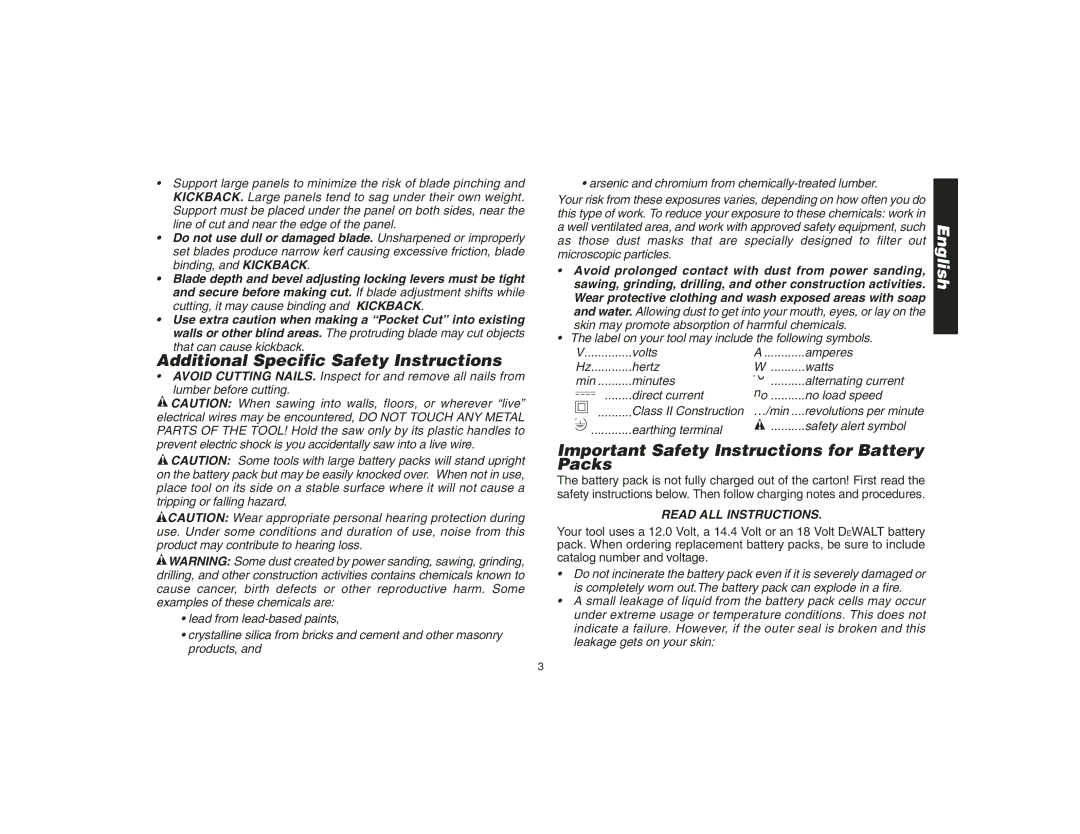
•Support large panels to minimize the risk of blade pinching and KICKBACK. Large panels tend to sag under their own weight. Support must be placed under the panel on both sides, near the line of cut and near the edge of the panel.
•Do not use dull or damaged blade. Unsharpened or improperly set blades produce narrow kerf causing excessive friction, blade binding, and KICKBACK.
•Blade depth and bevel adjusting locking levers must be tight and secure before making cut. If blade adjustment shifts while cutting, it may cause binding and KICKBACK.
•Use extra caution when making a “Pocket Cut” into existing walls or other blind areas. The protruding blade may cut objects that can cause kickback.
Additional Specific Safety Instructions
•AVOID CUTTING NAILS. Inspect for and remove all nails from lumber before cutting.
![]() CAUTION: When sawing into walls, floors, or wherever “live” electrical wires may be encountered, DO NOT TOUCH ANY METAL PARTS OF THE TOOL! Hold the saw only by its plastic handles to prevent electric shock is you accidentally saw into a live wire.
CAUTION: When sawing into walls, floors, or wherever “live” electrical wires may be encountered, DO NOT TOUCH ANY METAL PARTS OF THE TOOL! Hold the saw only by its plastic handles to prevent electric shock is you accidentally saw into a live wire.
![]() CAUTION: Some tools with large battery packs will stand upright on the battery pack but may be easily knocked over. When not in use, place tool on its side on a stable surface where it will not cause a tripping or falling hazard.
CAUTION: Some tools with large battery packs will stand upright on the battery pack but may be easily knocked over. When not in use, place tool on its side on a stable surface where it will not cause a tripping or falling hazard.
![]() CAUTION: Wear appropriate personal hearing protection during use. Under some conditions and duration of use, noise from this product may contribute to hearing loss.
CAUTION: Wear appropriate personal hearing protection during use. Under some conditions and duration of use, noise from this product may contribute to hearing loss.
![]() WARNING: Some dust created by power sanding, sawing, grinding, drilling, and other construction activities contains chemicals known to cause cancer, birth defects or other reproductive harm. Some examples of these chemicals are:
WARNING: Some dust created by power sanding, sawing, grinding, drilling, and other construction activities contains chemicals known to cause cancer, birth defects or other reproductive harm. Some examples of these chemicals are:
•lead from
•crystalline silica from bricks and cement and other masonry products, and
• arsenic and chromium from
Your risk from these exposures varies, depending on how often you do this type of work. To reduce your exposure to these chemicals: work in a well ventilated area, and work with approved safety equipment, such as those dust masks that are specially designed to filter out microscopic particles.
•Avoid prolonged contact with dust from power sanding, sawing, grinding, drilling, and other construction activities. Wear protective clothing and wash exposed areas with soap and water. Allowing dust to get into your mouth, eyes, or lay on the skin may promote absorption of harmful chemicals.
•The label on your tool may include the following symbols.
V | volts | A | amperes | ||
Hz | hertz | W | watts | ||
min | ..........minutes | no | alternating current | ||
|
|
| direct current | no load speed | |
|
|
| |||
|
|
| ..........Class II Construction | …/min .... | revolutions per minute |
|
| ............ | earthing terminal |
| safety alert symbol |
|
|
|
| ||
|
|
| .......... | ||
|
|
|
| ||
|
|
|
|
| |
Important Safety Instructions for Battery Packs
The battery pack is not fully charged out of the carton! First read the safety instructions below. Then follow charging notes and procedures.
READ ALL INSTRUCTIONS.
Your tool uses a 12.0 Volt, a 14.4 Volt or an 18 Volt DEWALT battery pack. When ordering replacement battery packs, be sure to include catalog number and voltage.
•Do not incinerate the battery pack even if it is severely damaged or is completely worn out.The battery pack can explode in a fire.
•A small leakage of liquid from the battery pack cells may occur under extreme usage or temperature conditions. This does not indicate a failure. However, if the outer seal is broken and this leakage gets on your skin:
English
3
